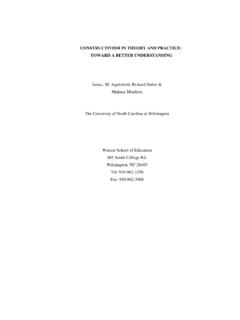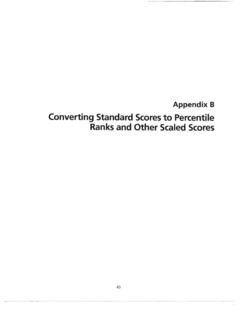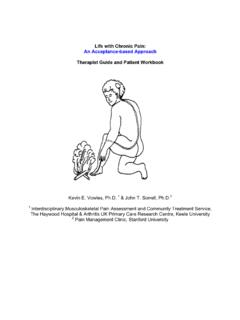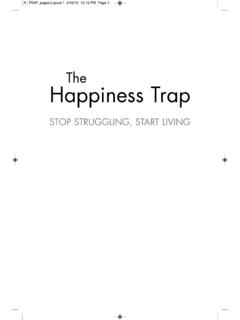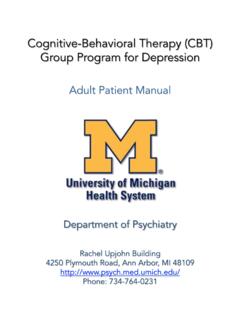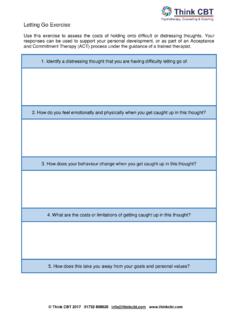Transcription of Acceptance and Commitment Therapy Group Therapy …
1 Page 1 of 38 1 | Page Acceptance and Commitment Therapy Group Therapy Manual for Self-Stigma and Shame in Substance Use Disorder Jason B. Luoma, Portland Psychotherapy Clinic, Research, & Training Center Barbara Kohlenberg, University of Nevada, School of Medicine Steven Hayes, University of Nevada, Reno Cite as: Luoma, J. B., Kohlenberg, B. S., and Hayes, S. C. (2005). Acceptance and Commitment Therapy Group Therapy Manual for Self-Stigma and Shame in Substance Use Disorder. Unpublished Manuscript. Developed as part of grant #5 R21 DA017644 from The National Institute on Drug Abuse (PI: Barbara Kohlenberg). Correspondence concerning this manual should be addressed to Jason Luoma, Portland Psychotherapy, 1830 NE Grand Ave., Portland, OR 97212, e-mail: We would like to thank Jody Eble and Kara Bunting for their assistance in the development of this manual, and the staff at Bristlecone Family Resources for supporting this project.
2 Commit Take action Accept Page 2 of 38 2 | Page TABLE OF CONTENTS Introduction .. 3 Session One Group .. 8 Session Two Group .. 15 Session Three Group .. 21 Appendix A: Metaphors and Exercises .. 25 Appendix B: Writing About Past Shame or Failure .. 33 Appendix C: The Life Question Sheet .. 35 Page 3 of 38 3 | Page Data supporting the use of this treatment manual This treatment manual was originally developed through an iterative process as described in: Luoma, , Kohlenberg, B. S., Hayes, S. C., Bunting, K., & Rye, , (2008). Reducing the Self Stigma of Substance Abuse through Acceptance and Commitment Therapy : Model, Manual Development, and Pilot Outcomes. Addiction Research and Theory, 16(2), 149-165. The intervention was then tested in a randomized clinical trial, the results of which are published here: Luoma, J.
3 B., & Kohlenberg, , Hayes, S. C., & Fletcher, L. (2012). Slow and Steady Wins the Race: A Randomized Clinical Trial of Acceptance and Commitment Therapy Targeting Shame in Substance Use Disorders. Journal of Consulting and Clinical Psychology. Abstract Objective: Shame has long been seen as relevant to substance use disorders, but interventions have not been tested in randomized trials. This study examined a Group -based intervention for shame based on the principles of Acceptance and Commitment Therapy (ACT) in patients (N = 133; 61% female; M = 34 years old; 86% Caucasian) in a 28-day residential addictions treatment program. Method: Consecutive cohort pairs were assigned in a pair-wise random fashion to receive treatment as usual (TAU) or the ACT intervention in place of six hours of treatment that would have occurred at that same time.
4 The ACT intervention consisted of three, two-hour Group sessions scheduled during a single week. Results: Intent-to-treat analyses demonstrated that the ACT intervention resulted in smaller immediate gains in shame, but larger reductions at four month follow up. Those attending the ACT Group also evidenced fewer days of substance use and higher treatment attendance at follow up. Effects of the ACT intervention on treatment utilization at follow up were statistically mediated by post treatment levels of shame, in that those evidencing higher levels of shame at post treatment were more likely to be attending treatment at follow up. Intervention effects on substance use at follow up were mediated by treatment utilization at follow up, suggesting that the intervention may have had its effects, at least in part, through improving treatment attendance.
5 Conclusions: These results demonstrate that an approach to shame based on mindfulness and Acceptance appears to produce better treatment attendance and reduced substance use. This manual is available for download to members of the Association for Contextual Behavioral Science at: There is also a manual describing the fidelity coding system at that same URL. I. Introduction A. Substance use disorders and the reduced opportunity live a vital, productive life. An individual with a substance use disorder suffers immense disadvantages in our culture. First, the deleterious effects of substance use and its sequelae on effective functioning are widely known. Second, the opportunities available to people with a history of substance use disorder, even when in recovery, can be sharply reduced.
6 Third, the individual with substance use disorder can curtail their own growth and development by applying a punitive, shame based, and defeatist perspective to their own goals and values in life. Page 4 of 38 4 | Page B. Stigma and Substance Use Disorders Some of the problems experienced by those with current or past substance use disorders can be understood as related to stigma. People who misuse substances are a heavily stigmatized Group (Crisp, Gelder, Nix, Meltzer & Rowlands, 2000). Individuals with substance use disorders are in a particularly disadvantaged position because these disorders are often believed to be self-inflicted, and thus generate highly pejorative cultural sentiment.
7 Direct acts or discrimination, as well as diminished opportunities offered to people with substance use disorder, can be understood as a manifestation of enacted stigma. Labeling someone as a substance abuser" or "addict tends to activate common stereotypes such as thinking that the person is likely to be unreliable, deceitful, or weak, among other stereotypes. This often leads to some sort of social sanction or devaluation, reducing the probability of the person being hired, or being trusted as a parent, friend, or lover. People who identify with a stigmatized Group often internalize the stereotypes associated with that Group . In addition the effects of enacted stigma, the emotional and cognitive barriers erected by the individual with substance use disorder in response to perceived or experienced stigma can also serve to obstruct access to opportunities.
8 The person may self identifies as a loser, being damaged goods, or always hurting others. Attachment to these self-conceptions entails giving upon important and valued life directions. These are manifestations of self-stigma. Accordingly, pejorative cultural beliefs have shaped public policy about substance use disorders, and the treatments that have arisen have been base on stigmatizing drug use and the drug user (Des Jarlais, 1995). Zero tolerance, the war on drugs, Project DARE and other policy initiatives of this kind seem to support stigmatizing attitudes toward substance abusers in the sense that negative judgments toward substance abusers are emphasized. It is also the case that people with substance use disorders may feel shame about their substance use.
9 Shame and self stigma are similar in that they point to indictments of one s character, rather than problem based descriptions of behavior. Rather than describe a history of problematic parenting behaviors that can be changed with effort and skill, eg. I really screwed up by being hung over at my kids , shame-based thinking would take the form of I am a parent who hurts my kids, I am a bad am a screw up. II . Acceptance and Commitment Training for self-stigma and substance use disorders Overview The present manual presents, in Group format, a mixture of instruction, discussion, and the use of metaphor and experiential activities designed to sensitize participants to the effects of self-stigma and shame on how they live their lives.
10 This training condition provides instruction and experiences that train participants to notice, and then to override, the very human tendency to categorize and then avoid aversive thoughts and feelings and the people and situations that evoke them. The Acceptance and Commitment training condition will cover the following topics: (a) introduction to enacted and self-stigma (b) cognitive defusion/behavioral flexibility (c) Acceptance vs. avoidance and control of emotions and thoughts and (d) values. Sessions include discussion and experiential exercises designed to help our clients see how natural it is to both have stigmatizing thoughts and to try to control, avoid, or get rid of these thoughts. We consider the possibility that thoughts and feelings themselves are not the problem, and that attempts to control or get rid of them are at the heart of how people get stuck.
